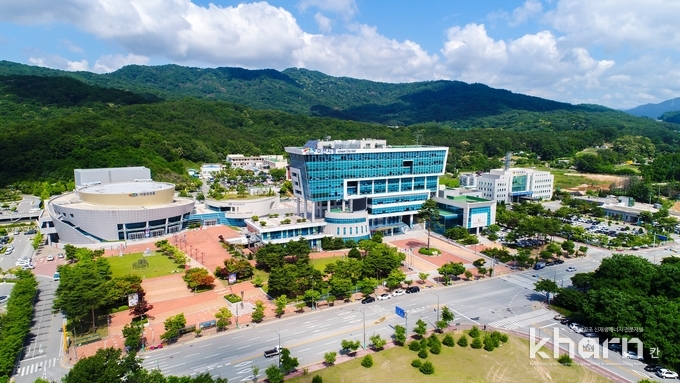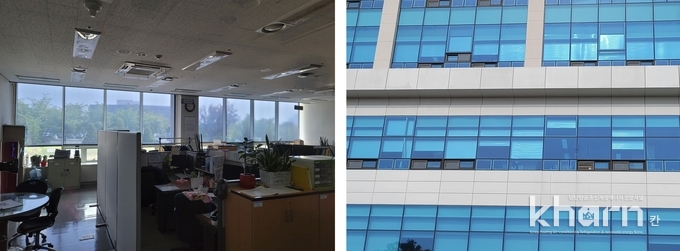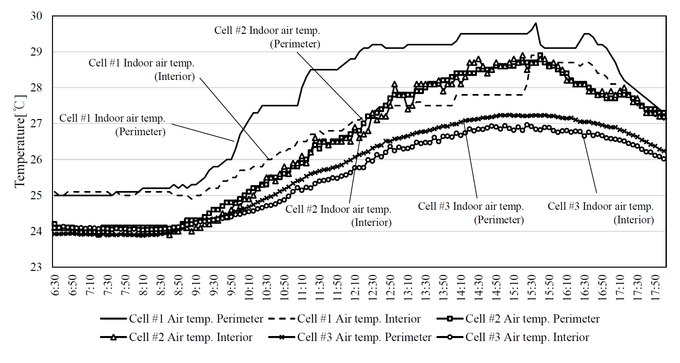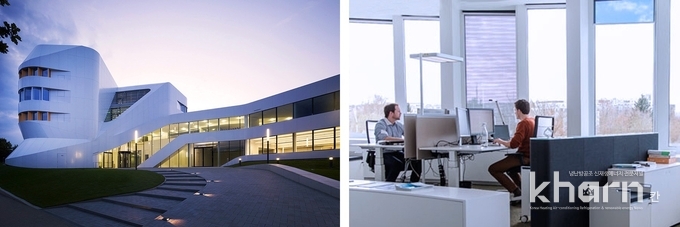“Icheon City Hall, Tangibly Experiencing the Solar Heat Reduction Effect of Multifilm”
After a pilot installation, additional installations requested… Installation completed for the entire 9 floors.
By Reporter In-gyu Lee igyeo@kharn.kr Registration Date: 2021-10-31

view of Icheon City Hall
Icheon City Hall (Mayor Tae-jun Eom) completed the installation of the operable solar heat-blocking multifilm system over the course of three years, finishing in May. As a result, during the scorching summer and autumn months with intense sunlight, high satisfaction levels were reported.
Icheon City Hall is a 9-story building with exterior walls made of glass curtain walls. During the summer months, the direct sunlight penetration led to an increase in indoor temperatures and issues such as glare, causing discomfort for the facility’s users, including government employees, citizens, and visitors.
Public buildings are required to maintain indoor temperatures above an average of 28°C when the cooling system is in operation, as per Article 14 of the “Regulations on Rationalization of Energy Use in Public Institutions.” While theoretically within the comfortable temperature range, this temperature may not provide a significant sense of coolness when entering from the hot outdoor conditions.
In such situations, areas adjacent to the windows often experience indoor temperatures 1-2°C higher due to incoming solar radiation, and the uneven distribution of intense sunlight leads to discomfort and constraints on indoor activities for occupants.
To alleviate these discomforts, Icheon City Hall initiated the installation of heat-insulating special films. This system offers the advantage of being operable based on external conditions such as weather and temperature, as it can be opened or closed selectively.
An official from Icheon City Hall stated, “When we conducted the pilot installation on the 6th floor in 2018, the results showed a significant decrease in indoor temperature. Employees from other floors who visited the pilot installation floor felt the temperature difference and requested additional installations. As a result, we proceeded with the installation for the entire building, completing it in May 2021, adding three floors each year since September 2019.”

Comparison of the interior (left) and exterior views of Icheon City Hall with Multi-Film DERSCHUTZ installations.
Improved External View and Cooling Load Reduction Effects
The Multifilm system “DERSCHUTZ” installed by Icheon City Hall, which is produced and supplied by Multifilm Korea (represented by Jeong-hye Bae), is a film blind. Even when installed on the interior side, it directly reflects sunlight to prevent an increase in indoor temperature due to solar radiation.
During this process, the honeycomb pattern flat embossing treatment on the layer surface results in a high reflectance rate, yet there are no concerns about external light reflection, and a smooth external view is achievable with minimal incoming visible light.
DERSCHUTZ blocks up to 88% of solar radiation, and its Solar Heat Gain Coefficient (SHGC) is an excellent 0.09. In an experiment presented at the 2019 Korean Solar Energy Society, comparing indoor temperatures in three different scenarios – no blinds, regular Venetian blinds, and DERSCHUTZ blinds – it was found that when the outdoor temperature was 30.1°C, the indoor temperature was 28.9°C in the other two cases. However, when DERSCHUTZ blinds were installed, the indoor temperature was lower at 26.9°C, approximately 2°C cooler.
As a result, it has received certification from the Solar Energy Society for reflecting more than 80% of the summer indoor solar radiation outward, resulting in approximately 50% reduction in cooling load. Furthermore, it can reduce cooling load by up to 75% depending on the type of glass used.
Typically, solar energy is composed of infrared, visible light, and ultraviolet rays. Infrared and ultraviolet rays cannot pass through regular glass and are reflected, while approximately 44% of visible light enters indoors. Visible light, on its own, does not directly affect temperature, but the issue lies in the wavelength form of visible light. When visible light touches objects, it is transformed into a form called near-infrared that cannot pass through glass, staying indoors and increasing the temperature. To prevent solar radiation from causing a greenhouse effect indoors, blocking the visible light component is crucial.
DERSCHUTZ exhibits a visible light blocking rate of 93-98%, effectively controlling indoor temperatures and reducing glare caused by solar radiation. During this process, only 2-7% of visible light allows for clear outside views while preventing outsiders from seeing inside, showcasing DERSCHUTZ’s technological strength.
In fact, prior to the installation of DERSCHUTZ at Icheon City Hall, tinting film and blinds were installed to alleviate discomfort caused by solar radiation. However, it was reported that these measures did not yield the desired results.
Typically, tinting films are designed to increase the visible light transmittance to a minimum of 30% or more to maintain an outward view. However, this can make it challenging to improve greenhouse effects.
MultiFilm Korea’s director, Jin-hang Lee, mentioned, “During the initial pilot installation of DERSCHUTZ at Ichon City Hall, the tinting film was not removed, which prevented us from fully utilizing DERSCHUTZ’s ability to reflect the visible light wavelengths. However, after removing the tinting film, we were able to perceive a noticeable reduction in indoor temperatures.”
MultiFilm is applying DERSCHUTZ to various public and government office buildings and facilities, including Ichon City Hall, and the business-to-government (B2G) transactions are expanding as a result.
Since its establishment in 2017 as JDL and subsequent name change to “MultiFilm Korea” in 2019, the company has expanded its portfolio with installations at various locations, including LH Paju Headquarters, Seoul Dongdaemun-gu Office, Seoul City University, Jeonju Deokjin-gu Office, Jeonbuk Provincial Government Disaster and Safety Division, Jeonbuk Development Corporation, Ulsan City Hall, Ulsan Nam-gu Office, Ulsan Urban Development Corporation, Ulsan Facility Management Corporation, Nakdong River Basin Environmental Office, Gyeongsan City Kindergarten, Gyeongsan City Health Center, and Uljin Port Control Tower, among others.

▲Comparison experiment of indoor temperatures after the application of MultiFilm Derschutz presented at the Solar Energy Society. Cell #1 represents no installation, Cell #2 has standard Venetian blinds installed, and Cell #3 features the installation of Derschutz.
Germany’s Fraunhofer Adopts Derschutz
MultiFilm Derschutz has also been implemented at the Fraunhofer Virtual Engineering Center, located in Stuttgart, Germany.
Fraunhofer is a leading applied research institution in Europe, operating 75 research centers throughout Germany with an annual budget of approximately 2.8 billion euros (around 3.7 trillion won). The institution actively collaborates with Korean institutions, associations, companies, and organizations in various fields, including building energy.
The fact that a globally renowned research institution with expertise in building energy has adopted Multifilm DERSCHUTZ is significant, as it has received recognition in terms of performance and effectiveness in the field of building energy.
The center, from its early stages, prioritized sustainability and received Gold-level certification from the German Sustainable Building Council (DGNB) upon completion of the facility.
This place was designed by the world-renowned architect Ben Van Berkel, who is the founder of UNStudio. UNStudio aims to design solutions contributing to climate change mitigation and has experience designing notable structures like the Mercedes-Benz Museum in Germany and the Erasmus Bridge in Rotterdam, Netherlands.
The center installed the DERSCHUTZ roller blinds, which are anti-glare systems for preventing glare in office spaces. They customized a special ceiling profile to directly mount 250 blinds on the ceiling without the need for a headbox during installation.
Jeong-hye Bae, the CEO of Multifilm, stated, “DERSCHUTZ is a luxury blind chosen by renowned architects worldwide,” and added, “We can provide a perfect solution to meet the requirements of clients and users.”
Furthermore, she emphasized, “Multifilm utilizes state-of-the-art materials developed in Germany for space exploration, incorporating high-reflectivity polyester film that allows for external visibility.” She also highlighted that this film system effectively provides heat insulation, prevents glare, and offers a clear external view.

▲ Installed in the German Fraunhofer Virtual Engineering Center (left) and office space, the Multifilm DERSCHUTZ

Direct Link to the Original Article

 한국어
한국어